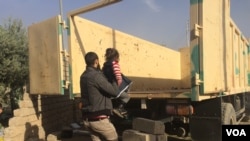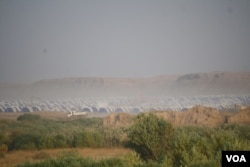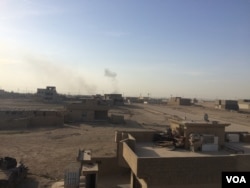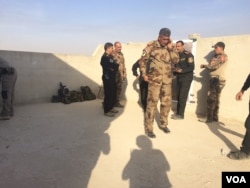In the outskirts of Mosul, bullets and mortar fire are nearly constant by day, and the occasional sound of an airstrike or a car being hit by a rocket makes no one look up.
Civilians still live in the area, some having fled the inner city in recent days, with no desire to move into the rapidly filling refugee camps just outside the war zone.
About 200 meters from the last suicide car bomb attack he has witnessed, Noaaf Zanoon lives with his family in a home someone else abandoned when they fled. In a nearby field of dust, the bodies of two IS soldiers now rot where they fell.
“Our house was shaking,” he tells us, offering us some of the lunch Iraqi soldiers had just handed him. When asked about what it is like living with the constant sound of battle, he laughs. In the relative safety of the outskirts of the city, he’s not afraid of the bullets.
“Islamic State fighters would come into our home and fight from inside it or right in front of it,” he says. “Sometimes they run from home to home to try to get the army to shoot the people.”
Commanders say three more Mosul districts have been recaptured from Islamic State militants but the fight is slow going because IS’s most powerful weapon at the moment is human shields.
“The biggest challenge we face is the presence of civilians because there are so many,” explains Lt. General Abdulwahab al-Saady, who commands counterterrorism forces from the front lines, at a base about two kilometers from where plumes of smoke mark the fighting in the inner city. “Some of these people are staying in their houses and refuse to leave.”
About 10 minutes later, a rocket hits a car soldiers say was rigged as a suicide bomb, another common IS military tactic, less than 300 meters away.
Downstairs, a constant stream of families pack into military trucks after fleeing the nearby violence. One man is held back because he is carrying a piece of IS-approved identification.
“IS was shooting at us as we ran away,” says 14-year-old Mashara, who is still wearing a black veil as required by IS. We ask her and other women if they are wearing their veils by choice.
“No, they made us,” says one woman as she boards the crowded truck. “We have just kept them on so people don’t take our pictures.”
Guarding Civilians Complex
On the dusty fields and amid the rubble, civilians who aren’t moving farther from the battle search for basic supplies, like wheat. Many carry white flags as they walk to declare that they are not IS escaped from their front line, a tactic commonly employed, as civilian vehicles stream out of the war zones, also bearing white flags — or rather white cloth tied to sticks — but not perfect, say some civilians.
“The militants sometimes hang white flags too,” explained Nadia Mustafa as she waited to get onto an Army bus to a refugee camp last week with a group of women all veiled in black. A few days later we meet her again at the camp, now unveiled and grinning in a pink headscarf.
Even people fleeing, she says, are sometimes infiltrated by IS militants and caught as they are screened at checkpoints and refugee camps. The International Organization for Migration says nearly 50,000 people have fled their homes as the Mosul offensive ends its forth week.
“There were two militants wearing veils among the women we came with,” she says. “They were wearing makeup and everything.”










